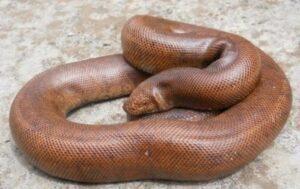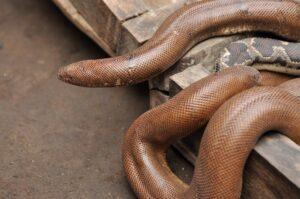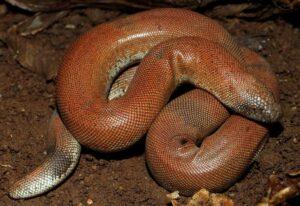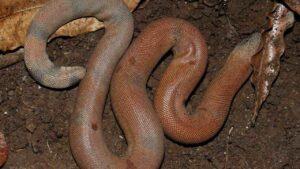The Indian sand boa indigenous to south and western Asia is also known as John’s sand boa, red sand boa, and brown sand boa. Its specific name, johnii, is in honor of the German naturalist Christoph Samuel John, a missionary to India. The world’s largest sand boa is adapted to burrow beneath the surface of the sand.
Scientific Classifications
- Suborder:Serpentes
- Family:Boidae
- Genus:Eryx
- Species:E. johnii
Conservation Status
Description
Size
The adults can rarely reach a length of more than 2 ft (61 cm). But some can attain as much as 3ft (91 cm) in length.
Color and Appearance
The color of this constrictor ranges from reddish-brown to dull yellow-tan.
Its wedge-shaped head has narrow nostrils and tiny eyes. Small, polished dorsal scales cover its cylindrical body. The blunt, rounded tail doesn’t look different from its body and appears truncated. It makes the snake look double-headed.
Are They Dangerous to Humans
Being a calm and non-aggressive snake, it has endeared itself to the exotic pet trade. But it can bite when touched in a buried condition without causing any danger as it is non-venomous.
The pets do well with gentle handling but may be hard to manage due to their extra-smooth, glossy scales.
Indian Sand Boas at a Glance
Distribution
The boa can be found in southern, western, and northwestern India, Iran, and Pakistan.
Lifespan
Like other sand boas, its longevity is 14-20 years.

Predators
It does not have any natural predators. The illegal wildlife trade is its main threat.
Diet
It primarily eats mammals like mice, rats, and other small rodents that it kills by constriction. Some of them will also take other snakes.
Reproduction
Ovoviviparous (gives birth to live young from eggs that hatch inside the body)
Late summer to monsoon season sees each female giving birth to up to 14 fully independent babies.
Care Sheet
Size of the Enclosure: An adult Indian sand boa can be housed in a 20-30 gallon aquarium.

Temperature: The ambient temperature of the enclosure should be 78-85°F with a basking temperature of 90-95°F.
Humidity: The humidity level in the cage should be around 50%. It doesn’t like high humidity levels and any dampness in its cage. A heavy water bowl should be provided that cannot be tipped over by the snake when it burrows.
Substrate: Course sand and smooth gravel are ideal substrates as they help it to burrow.
Feeding: Young mice should be fed to the adult red sand boa every 10-14 days. The same can be given to the babies once a week.
Source
i.pinimg.com, panda.org, live.staticflickr.com, mages.firstpost.com, amazonaws.com








